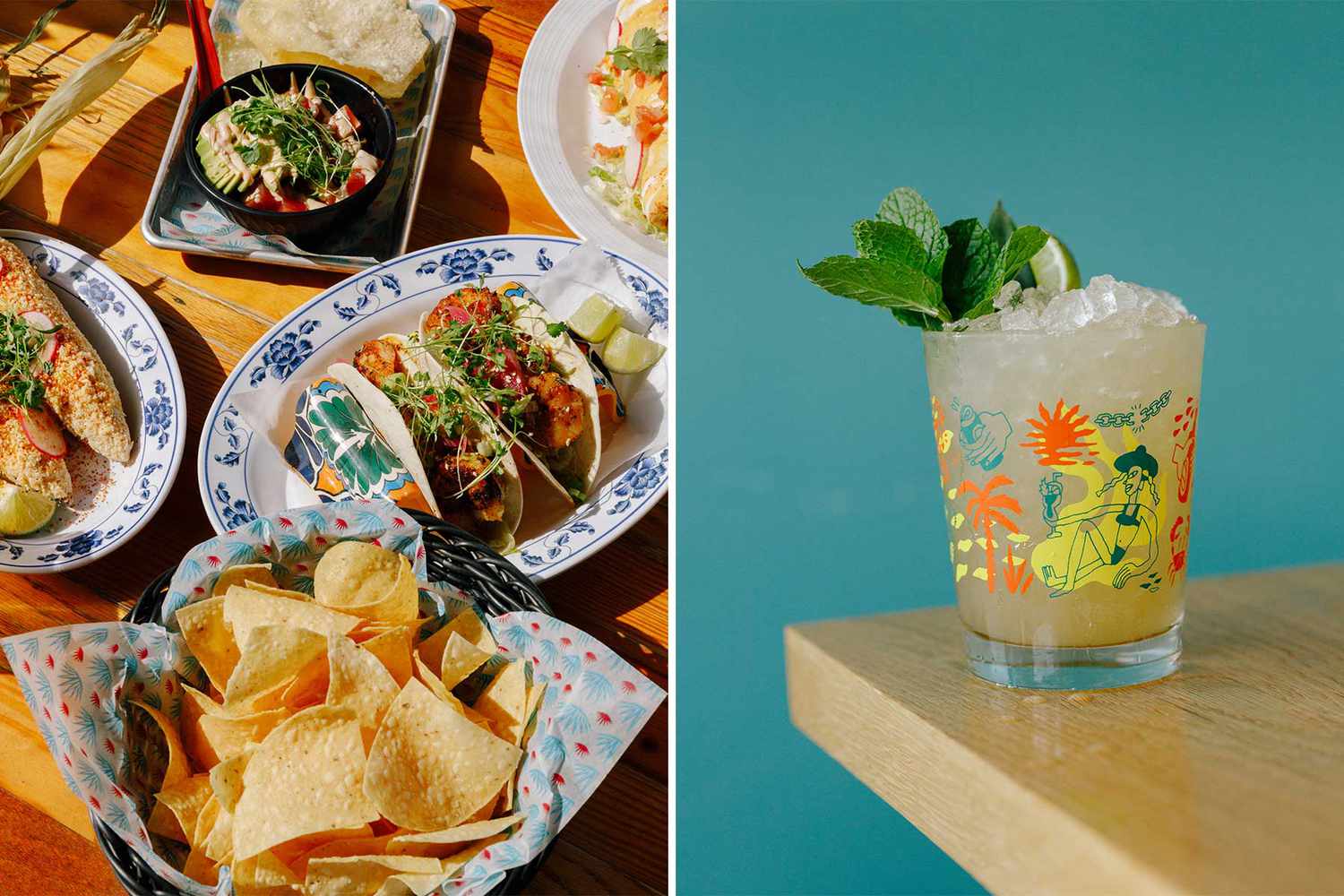:max_bytes(150000):strip_icc()/TAL-jotoro-tacos-wild-child-mai-tai-TAMPA1022-cf18b5c4fd4348b19d9e8f0447fd6626.jpg)
Like most Cuban Americans living in South Florida, I’ve always known my community had two main hubs in the state: Miami, my home city, and Tampa. While our Cuban influence in Miami is world-famous, our presence in Tampa has stayed relatively under-the-radar. Sure, the town was always an old-school kind of place to go for incredible sandwiches and cigars (often sold by fourth- or fifth-generation Cuban Americans). Its downtown was mainly a commercial hub; it wasn’t a place to live.
In the past several years, that’s changed.
It hit me all at once last year when I made the one-hour flight from Miami to spend a week in the city, which included a stay at the recently opened JW Marriott Tampa Water Street. The striking glass-and-steel high-rise is part of a 56-acre planned neighborhood called Water Street Tampa. The hotel typifies the changes taking place downtown, and has become a gathering place not only for guests but also for residents of the surrounding community.
The JW Marriott’s soaring lobby is a people-watcher’s dream: I saw basketball players from the Toronto Raptors, in town for the season; suit-clad businesspeople revving their entrepreneurial engines post-pandemic; and Floridians like me, having a cocktail and checking out the type of high-end hotel that, just a few years ago, would have been unimaginable in this city.
James Jackman
The JW Marriott has been joined by other hospitality newcomers like the Tampa Edition, which opens this month in the same development. The 26-story tower has 172 guest rooms designed by Roman & Williams, the New York–based firm known for its work on the ultra-cool Ace Hotels in New York and New Orleans, as well as the recently renovated British Galleries at the Metropolitan Museum of Art. Chef John Fraser, a French Laundry alum, will create the menus at three of its restaurants and bars.
To a casual observer, Tampa’s shiny new image may seem to have appeared out of nowhere. Florida’s third-largest city (behind Jacksonville and Miami) had been due for a revamp — and much of its redevelopment is thanks to former financier and Tampa local Jeff Vinik. He bought the Tampa Bay Lightning hockey team in 2010, and began acquiring property surrounding Amalie Arena, its downtown stadium. The land consisted mostly of parking lots and the kinds of establishments you frequent when you have a hankering for frozen daiquiris or hot wings (Hooters, incidentally, was founded right here in the area). Partnering with a private investment firm, Vinik continued to buy more waterfront property. His vision, widely publicized, was to create a highly livable city for the future.
Based on my visit, I’d say Vinik succeeded, and downtown Tampa today feels like a walkable community where you can live, bike, run, ride a scooter, buy groceries, go to the gym, catch a hockey game, and have dinner in some of the best restaurants in Florida — all within less than a square mile. All of this has had a halo effect: other parts of the metropolitan area, including the Cuban-American-dominated neighborhood of Ybor City (just north of downtown), and even St. Petersburg (just across Tampa Bay), are also getting newfound attention.
Each morning of my stay at the JW Marriott, I ran the length of the Riverwalk — a 2.4-mile-long pathway that winds along the Hillsborough River — together with the neighborhood’s burgeoning population of young professionals and digital nomads getting in some exercise before starting the workday. The Riverwalk connects the two ends of downtown Tampa, with Sparkman Wharf at one end and Armature Works at the other. Also developed by Vinik’s investment group, both are open-air complexes with food and drink as their focus. Between those two points, you’ll find the mix of cafés, restaurants, beer gardens, and, yes, Cuban sandwich shops that is the lifeblood of the city.
James Jackman
My food tour included Mexican-style grilled corn on the cob with perfect flavor mix of lime, chiles, and cheese at Jotoro, in Sparkman Wharf. Chef Joe Isidori’s food feels like a party, a little bit of Tex-Mex in Tampa.
Also in Sparkman Wharf is an area that showcases the city’s version of street food in a series of short-leased shipping containers that give chefs (both established and emerging) a place to experiment. I soaked up all the tequila I’d tried at Jotoro with roasted-sweet-potato tacos from Gallito Taqueria, by chef Ferrell Alvarez. He’s known for restaurants like the Rooster & the Till, which serves New American dishes made with locally sourced ingredients in the increasingly popular neighborhood of Seminole Heights, five miles north of downtown.
Exploring the city shouldn’t just be all about the new, though. I also stopped in at one of Tampa’s old-time greats, Bern’s Steak House, in the Hyde Park district. Bern’s is all gold-and-red trimmings, rococo busts and chandeliers: it’s the opposite of the sleek look of modern Tampa, but has great steaks and a bible-size wine list that’s one of the largest in America. Reservations are usually required, but I went late at night without one and headed up to the special dessert room upstairs, which feels like a speakeasy for sweets. I ordered the macadamia ice cream and a Bern’s Cappuccino, which is brewed from coffee marinated in liqueur.
While the lion’s share of development is happening downtown, Ybor City — a 15-minute hop north on a streetcar — is the heart of the city’s Cuban-American community. To fully understand the fabric of Tampa, it’s essential to spend some time here. Ybor City, now part of the city of Tampa, was founded in 1886 by Vicente Martinez Ybor, Ignacio Haya, and other entrepreneurs who wanted to make and sell cigars. With this newly arrived industry came immigrants from Cuba, Spain, and Italy looking for work. Keeping the cigar rollers fed, caffeinated, and well informed called for a city of coffee brewers, newspaper and book sellers, and Italian bakers. Think turn-of-the-20th-century boomtown, with clapboard houses, churches, schools — and, of course, restaurants, which popped up around the factories. To see some of this history today, head to J.C. Newman Cigar Co., the country’s oldest family-owned cigar maker still in operation.
James Jackman
Seventh Avenue is Ybor City’s main drag. At its eastern end is Columbia Restaurant, a cornerstone of the city and, for Cuban Americans, a public clubhouse of sorts. It’s owned by the Gonzmart family, who have run the place since it opened in 1905. If Vinik is the new name heard around town, Gonzmart was the original. If you’re Cuban, the arroz con pollo and ropa vieja is the kind of cuisine you might find in your grandmother’s kitchen.
At Seventh Avenue’s western end is another newcomer, the Hotel Haya, which opened two years ago and is named after Ignacio Haya, the cigar maker. It’s a gorgeous modern building with 178 rooms, designed by the architect Alberto Alfonso, who fled Cuba as a child in 1960. The hotel’s restaurant, Flor Fina, serves a simple side of black beans that was one of the most incredible dining experiences I’ve had in ages. It took me back to my family’s Miami kitchen, where my grandmother would hum Spanish lullabies, and I could catch the scent of laurel leaves drifting in the window. There are fancier, more beautiful dishes on the menu, but for me, this one represents ultimate comfort.
Off Seventh Avenue, there are yet more treasures to be found. My favorite is the tiny José Martí Park, a plot of land that pays tribute to Cuba’s patriot poet, who died fighting for the country’s independence. It’s also a piece of Cuba in Tampa — literally. It was donated to the people of Cuba in 1956, three years before the revolution, and remains the only U.S. property owned by the country aside from the embassy in Washington, D.C. Whenever I step on Cuban soil while remaining in my home state, my heart flutters.
James Jackman
When locals talk about Tampa, they’re talking about the entire area around Tampa Bay, and this includes the city’s artsy neighbor, St. Petersburg.
St. Pete used to be known as a sleepy home for retirees, but new development is infusing the town with youthful energy. A futuristic pier opened in the summer of 2020 with five restaurants, an environmental-education center, and a display of cutting-edge contemporary art from the likes of cultural activist Xenobia Bailey and sculptor Nathan Mabry.
Art, in fact, has become the star of St. Pete, thanks in large part to the Dalí Museum. Opened in 1982, the institution debuted a new building in 2011 designed by architect Yann Weymouth. It’s a surreal mix of concrete and glass, topped with a dome known as the Enigma, which is made up of 1,062 panes of glass. With more than 2,000 of Salvador Dalí’s works, it’s the largest collection outside his native Spain.
The programming here is consistently thought-provoking, and the current exhibition, “Paul Éluard: Poetry, Politics, Love” (running through January 8, 2023) delves into the life of the French poet — another leading figure of the surrealist movement of the 1920s. After I visit, I always stop by the neighboring restaurant Wild Child to soak in the colorful, beautifully designed space. I’ll order a Spritz or Paloma cocktail and mentally unpack all of the mind-bending pieces I’ve just seen.
For even more art, there’s the Imagine Museum, with its vast display of works in glass, including some by Dale Chihuly and Trish Duggan. And for craft enthusiasts, Florida CraftArt hosts exhibitions that range from ceramics and jewelry to sculpture and mixed media, all by Floridians.
After this whirlwind of visual stimulation in St. Pete, I found myself spending my last day in Tampa sitting on the balcony of my room at the Hotel Haya, listening to a rooster crow down below. I was looking out past one of the city’s classic gay clubs across the street, beyond the remnants and echoes of cigar factories, imagining the bustle of this district in the early 1900s.
For all its shimmering new buildings, new developments, and new residents, the traces of this town’s immigrant history are still palpable. And it occurred to me then that Tampa is an emblem of modern America. This is where fresh roads are being paved through our ever-evolving national identity. And yet it’s still a place where a Florida girl like me can always feel at home.
A version of this story first appeared in the October 2022 issue of Travel + Leisure under the headline “Tampa Rising.”








